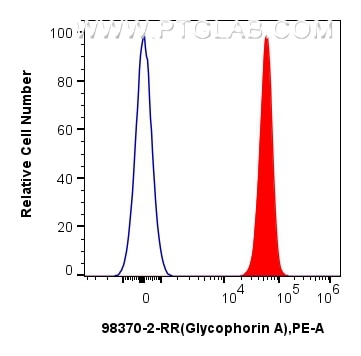Tested Applications
| Positive FC detected in | Human peripheral blood erythrocytes |
Recommended dilution
| Application | Dilution |
|---|---|
| Flow Cytometry (FC) | FC : 0.25 ug per 10^6 cells in 100 μl suspension |
| This reagent has been tested for flow cytometric analysis. It is recommended that this reagent should be titrated in each testing system to obtain optimal results. | |
| Sample-dependent, Check data in validation data gallery. | |
Product Information
98370-2-RR targets Glycophorin A/CD235a in FC applications and shows reactivity with human samples.
| Tested Reactivity | human |
| Host / Isotype | Rabbit / IgG |
| Class | Recombinant |
| Type | Antibody |
| Immunogen | Recombinant protein Predict reactive species |
| Full Name | glycophorin A (MNS blood group) |
| Calculated Molecular Weight | 150 aa, 16 kDa |
| GenBank Accession Number | BC005319 |
| Gene Symbol | Glycophorin A |
| Gene ID (NCBI) | 2993 |
| Conjugate | Unconjugated |
| Form | Liquid |
| Purification Method | Protein A purification |
| UNIPROT ID | P02724 |
| Storage Buffer | PBS with 0.09% sodium azide, pH 7.3. |
| Storage Conditions | Store at 2 - 8°C. Stable for one year after shipment. |
Background Information
Glycophorin A (GYPA) is the major transmembrane sialoglycoprotein in erythrocytes. It is a dimeric type I transmembrane protein carrying 15 closely clustered O-linked tetrasaccharides capped with sialic acid/N-acetylneuraminic acid (Neu5Ac). This 36 kDa protein represents the major sialoglycoprotein of the red blood cell membrane displaying about one million copies per cell. (PMID: 9490702)
Protocols
| Product Specific Protocols | |
|---|---|
| FC protocol for Glycophorin A/CD235a antibody 98370-2-RR | Download protocol |
| Standard Protocols | |
|---|---|
| Click here to view our Standard Protocols |



